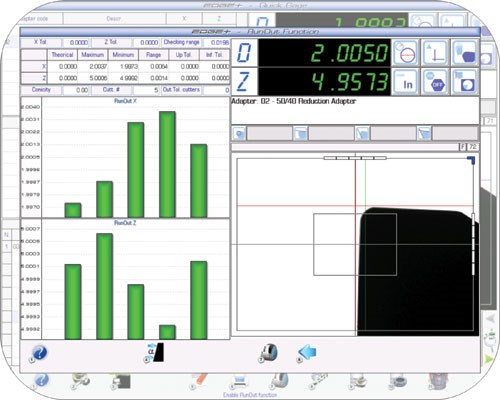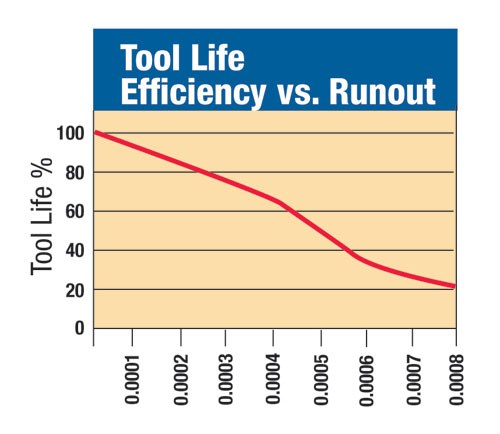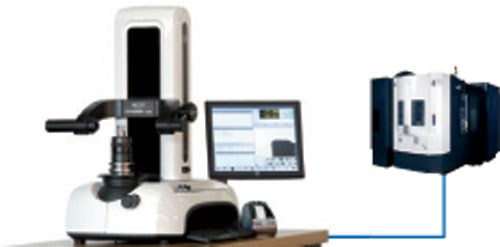Presetting Pays Dividends
Many shops are moving away from centralized toolroom operations and opting instead for distributed tool presetting on the shop floor. The presetting machines available today are accurate, easy to use and provide closed-loop tool compensation on the CNC machine tool, saving significant time during job change-over.
The demand for intricate, Swiss-type machining capabilities shows no signs of slowing. Industries that require small, complex and painstakingly accurate parts—such as technology and medical—continue to grow, and competition is fierce. To remain viable and cost effective, more manufacturers have invested in multi-axis, CNC Swiss-type lathes and turn-mill centers to cut cycle times and meet increasingly rigorous part tolerances. And it’s no small investment.
Still, despite the significant capital expense of these machines, some shops aren’t getting the most from them; when operators touch off tools on the machine and manually enter offsets, shops lose valuable time, tool life, materials and, ultimately, money.
Idle Machine Time Adds Up
The more expensive the machine, the higher the opportunity cost when it sits idle. Time that operators spend touching off tools and running trial cuts could be spent on part production. Even machines that feature more refined laser measuring devices or touch-off probes must remain out of service for at least a few minutes during setup—time that adds up over days, weeks and years.
Consider, for example, a shop that runs four CNC Swiss-type machines at a rate of $80 per hour. If each tool change requires 1 hour of setup and there are two tool setups per day, per machine, the shop loses $640 per day in time the machines sit idle.
This amounts to an astonishing $160,000 per year. In fact, experience and anecdotal evidence shows that most machines cut metal less than 50 percent of the time during working hours—sometimes even less in environments with shorter part runs.
What’s more, this calculation doesn’t consider the costs associated with broken or worn-out tools and toolholders (because of improper measurements and test-cut mishaps), rework and scrap, and the potential need for additional machines to pick up the slack while others remain idle during setup. It is estimated that large job shops, for example, can reduce tooling costs by as much as $100,000 per year by simply using a presetter.
No Room for Error
When it comes to Swiss-type tooling and micro-machining scenarios, one one-thousandth of an inch can make or break an expensive part or tool, and the tight tolerances set forth by customers require exacting precision.
Human error can be another cause for concern: Touching off tools and manually entering offsets is risky—especially when dealing with tolerances of less than 0.0001 inch. Subpar parts, reduced tool life and rework all add up to unnecessary costs.
Part of a Comprehensive Setup Strategy
Bringing tool setup offline with the help of a presetter—and implementing a streamlined setup strategy—can alleviate costs and hassles associated with tool changes. Sophisticated, non-contact presetters are recommended for Swiss-type tooling applications because they have the capabilities necessary for the complex, high-speed nature of this kind of machining.
The optical and shadow-graph technology of these presetters enables manufacturers to accurately measure tool length and diameter, calculate nose radii and angles, and detect damaged or unusable cutting edges. These types of presetting technologies have become so advanced that they can calculate runout to less than 0.000078 inch TIR.
When dealing with micro-sized tools, runout (how far from the true center the tool rotates) is an extremely critical factor. Small tool size accentuates any runout in the machine spindle, toolholder and collet. In other words, the smaller the part, the more effect runout has on finished part quality.
What’s more, tools that do not run concentric to their centerline are susceptible to worse wear and tear on one side of the tool. Reducing runout can therefore significantly increase tool life, yielding major long-term cost savings. Improving runout from 0.0006 inch to 0.00008 inch, for example, can triple tool life for solid carbide tools.
Some new presetters supply numeric and graphical representations of runout. Users simply rotate the spindle 360 degrees and the presetter program will automatically measure each tool to calculate runout. Knowing whether or not a tool’s runout value is acceptable before giving the tool the green light for use is a must in micromachining.
In addition to microscopic tool inspection, non-contact presetters have software-integration capabilities, allowing them to connect to shop-floor networks and tool information databases. This functionality has led to a new trend in tool management—one that allows manufacturers to streamline the entire tool change process.
First, manufacturers establish one central tool crib, if they don’t have one already. Rather than let machine operators fend for themselves, choosing tools they think may be right for a job and touching them off at their machines, some manufacturers staff one or two skilled and knowledgeable machinists to serve as dedicated crib attendants.
In the crib, each new job begins: Crib attendants assemble carts with the appropriate tools and holders, and preset each assembly. When paired with intelligent software systems, manufacturers can document the results of the preset process, store them in a database for future use, and make the necessary offset data available for operator download at the proper machine control. This virtually eliminates the potential for human error and can reduce tool setup time by more than 90 percent, in some cases.
Presetters can also interact with tool management software, which gives manufacturers a better grip on tool inventory and strategy—another optimization that can save big bucks over the long haul.
When One is Not Enough
While many shops find that one presetter in a centralized tool crib is sufficient to service the entire shop floor, others realize that demand requires more than one presetter to handle all the shop’s tool changes. In this case, manufacturers may have a presetter at each machine cluster, allowing operators to preset tools themselves, close to their stations, and eliminating the need to hire an experienced machinist as a crib attendant.
Rather than hook up to a computer network for the entire shop floor, these presetters can connect directly to the machines in their cluster. While having multiple presetters close to machines on the shop floor may be a good choice for some manufacturers, it’s important to take environmental conditions into consideration.
Temperature changes and dusty or dirty conditions on the shop floor, for example, can affect presetter accuracy and repeatability. Aluminum and steel expand and contract with temperature changes—sometimes enough to interfere with a presetter’s calibration.
Fortunately, thanks to advances in design, manufacturers can find presetters made of thermally stable materials, such as aged cast iron, and presetters with enclosures to protect against dust, coolant and other shopfloor contaminants.
While these features may come with a higher price tag, they allow manufacturers to use presetters near machines on the shop floor and eliminate the need for a temperature-regulated, cleanroom environment in which to house a presetter.
The Right Presetter
Just like a machine tool, a presetter can be a big investment, but it’s one that typically pays for itself in a matter of weeks. Also, like machine tool purchases, manufacturers should consider all of their options and work with a partner that can help them identify—or create—a presetter system that fits their manufacturing environment.
The first thing to consider when purchasing a presetter is the design and features offered. In most manufacturing situations—and with Swiss-type tooling applications specifically—high rigidity, high force retention-knob clamping and minimal runout are crucial to ensure repeatability and accuracy. Presetters should also be designed to replicate the machining environment as closely as possible to achieve the most accurate measurements, meaning they should have similar design and construction features.
As mentioned before, subpar construction can leave presetters susceptible to damage. Manufacturers should look for presetters made from aged cast iron. Enclosed designs are available to protect the machines from contaminants, when necessary.
Presetter manufacturers and dealers will often work with manufacturers to devise a customized tool setup strategy—including decisions on how presetters will integrate with machines and other shopfloor software. They can also help determine if a centralized toolcrib setup is ideal, or if a presetter for each machine cluster is more appropriate.
Some manufacturers see presetters as an extravagant luxury. To the contrary, tool presetters can deliver quick ROI for the shops that employ them—particularly when it comes to complex, small-parts machining. Not only do presetters help save money, but they can also give job shops the productivity boost they need to reach new heights in the areas of efficiency, customer acquisition and profit.
Related Content
Succession Planning: Three 15-Minute Activities to Start Preparing for Tomorrow
Succession planning is planning for the future success of your business.
Read MoreEmerging Leader's Dedication to Education
Instilling confidence throughout a shop floor can do wonders for company morale while increasing productivity.
Read MoreTraining Is More Than a Skills Upgrade
Training is more than a skills upgrade. Training is a process that creates a virtuous cycle for your performers, culture and shop. Why do we train? Why do we need to train?
Read MoreThe Value of Aligning Efforts to Promote Manufacturing Careers
Successfully building the next generation of manufacturers requires a team effort between employers, educators and parents. Each of these three groups has a tremendous impact on young people’s career decisions. Without the support of all three, we are unlikely to bridge the skilled labor shortage that threatens the future growth of our industry.
Read MoreRead Next
A Tooling Workshop Worth a Visit
Marubeni Citizen-Cincom’s tooling and accessory workshop offers a chance to learn more about ancillary devices that can boost machining efficiency and capability.
Read More5 Aspects of PMTS I Appreciate
The three-day edition of the 2025 Precision Machining Technology Show kicks off at the start of April. I’ll be there, and here are some reasons why.
Read MoreSeeing Automated Workpiece Measurement in Real Time
User-friendly inspection software for CNC machining centers was shown at IMTS 2024 monitoring measurements between and after machining while performing SPC based on recorded measurement values.
Read More

























